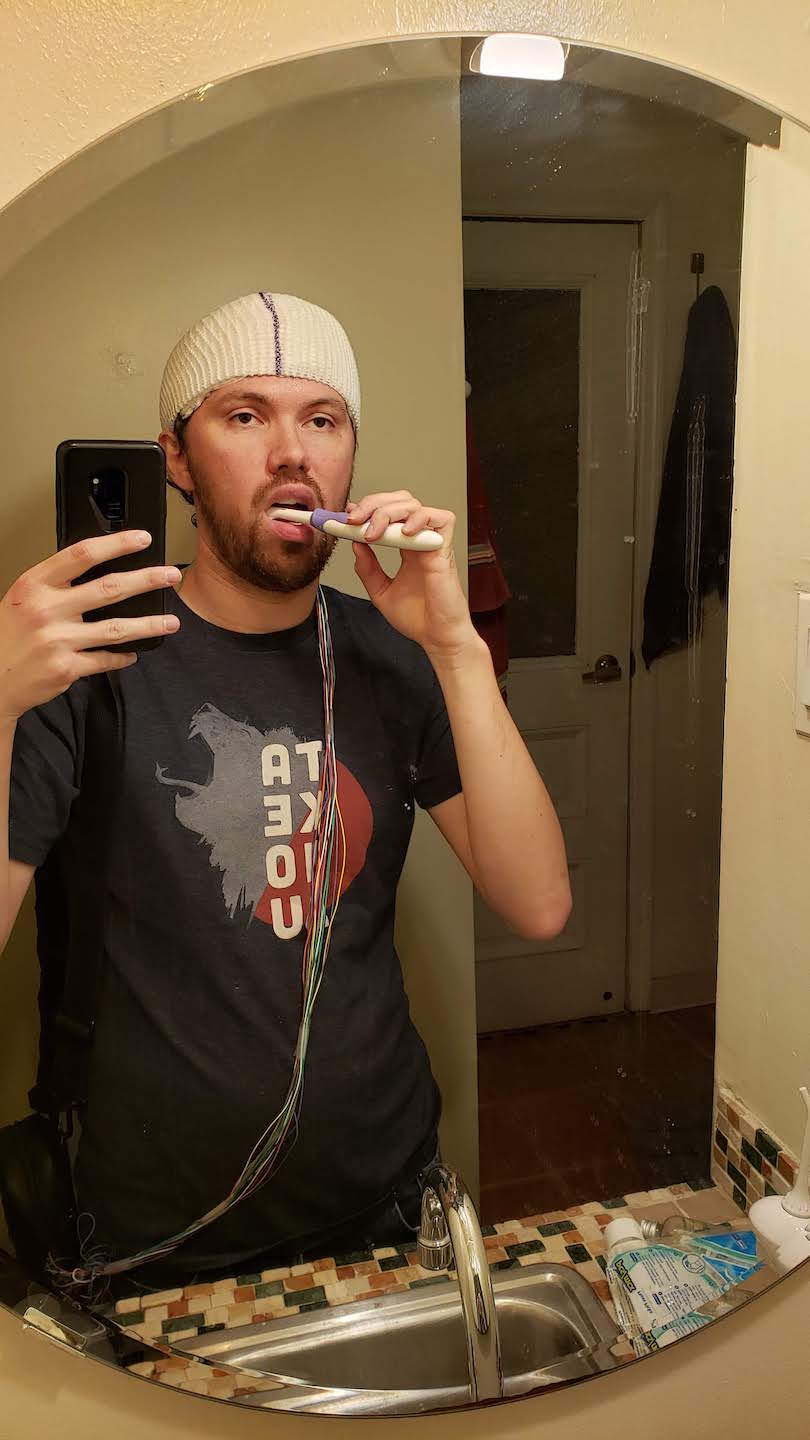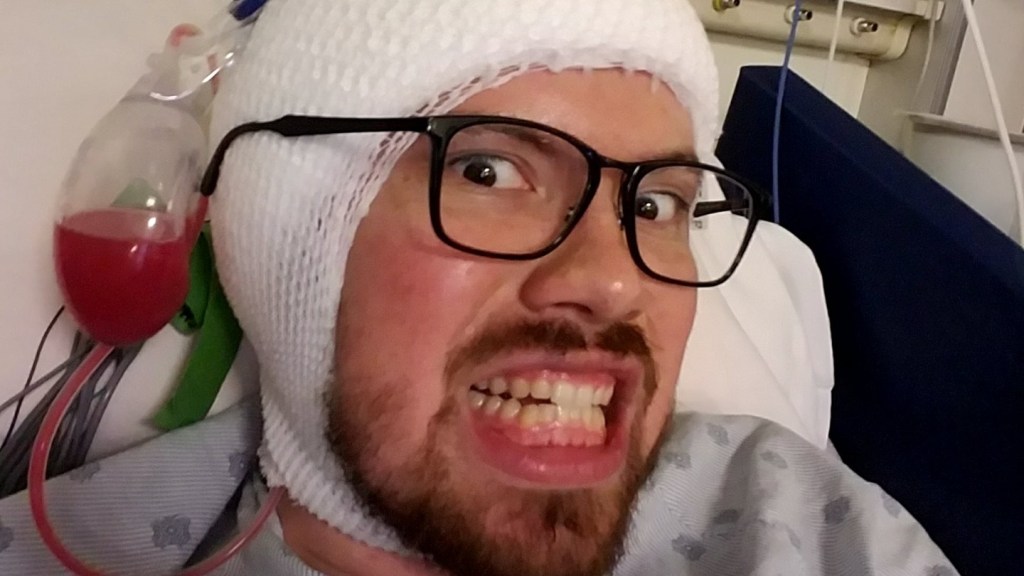Until the age of 28, Jody Smith was plagued by the knowledge that one day he was going to die.
Perhaps this was due in part to the fact that his dad and brother both perished while he was young; perhaps it was also due to a physical defect that caused his nervous system to misfire. In any case, the fear of his inevitable mortality consumed his thoughts, racking him with anxiety and sapping him of his mental energy.
Videos by VICE
Until he had part of his brain cut out.
It was the right amygdala, to be exact: a small collection of cells near the base of the organ that constitutes a person’s threat-response circuitry, analysing sensory information and, in certain situations, triggering those emotions that we typically associate with “fear.”
Now Smith, 32, isn’t “afraid” of anything. On a primal, physiological level at least, he has been rendered completely fearless.
“When I say I no longer feel ‘fear,’ I am using the word to describe a very unique feeling,” Smith, who lives in New York City, tells VICE over email. “People describe a lot of things with the word ‘fear’ – like ‘I’m afraid of girls’ or ‘I’m afraid of failure’ – but I’m talking about the fear you’d feel when facing death or serious injury. That’s the fear that was removed.”
Ever since undergoing complex brain surgery, Smith says, “my reptilian harm-avoidance has been replaced with a more logical version.”

Smith was diagnosed with epilepsy at the age of 26. About three times a day, without warning, he’d started experiencing brief, intense emotional sensations that made him feel as though something bad was about to happen, or had just happened, triggering a panicky, fight-or-flight response. Even for someone who’d spent his whole life wrestling with anxiety and existential dread, this was a new development.
It wasn’t initially clear that these were epileptic seizures; for the most part, they amounted to little more than minor inconveniences. But some were worse than others.
At one point Smith started feeling the onset of his symptoms at a family gathering and, taking a walk outside to get some fresh air, blacked out. Twenty minutes later, he came to and discovered he’d been stumbling and crawling around in the neighbour’s yard as if drunk. He barely remembers it. An epilepsy specialist diagnosed his condition shortly thereafter.
“Surgery was the only option to prevent the chance of the seizures getting worse, continuing to damage my brain, or potentially killing me,” Smith explains. And so, after two years of trying and failing to treat his condition with various medications, he went under the knife.
The surgery was two-stage. First, doctors implanted probes deep in Smith’s brain, then spent a week trying to trigger a seizure so they could locate the part that was causing the issue. During that time, Smith says he intentionally “tortured” himself to try and trigger a seizure – mostly by depriving himself of sleep and listening to Skrillex at full volume. At one point, he recalls, doctors prescribed him a beer to try and move things along.
At the end of the seven days, and following a neuropsychological exam, surgeons ultimately decided to target Smith’s temporal lobe: removing the front half of the right temporal lobe, the right amygdala and the right hippocampus before stapling his head back together. Three days after the surgery, Smith was free to leave the hospital. And straight away, he says, he noticed something in him had changed.
“I was very different right after surgery,” he recalls. “I would get stressed out by noises that would have previously triggered a seizure … [and] I developed several deficiencies including ADD and memory issues.”
Within two weeks, Smith noticed something else: his abiding fear of the void had dissolved; he was no longer haunted by the fact that he would eventually die. On face value, this seemed to be a positive development. It wasn’t until more than a year after the surgery, however, that he realised the extent to which his fear responses had short-circuited.
It happened one day while he was walking through Newark, New Jersey, when a random woman yelled out to a group of five similarly dressed men across the street and pointed at him. The men approached, fanning out across the sidewalk, and rapidly closed in on Smith. He consciously acknowledged without any uncertainty that he was about to be mugged. And yet, rather than tremble or cower or even sidestep the approaching mob, he kept walking, casually, straight through their ranks. It was as much a surprise to him as to his would-be assailants.
“Apparently,” he says, “my lack of fear struck them.”
A short while later, Smith again caught himself acting uncharacteristically nonchalant when he was bitten by a spider.
“I just sort of looked at it – I didn’t even flick it away instinctually,” he recalls. “I was like ‘oh wow, I was just bitten, and that hurts. I wonder what I should do now?’”
Smith soon started experimenting with his newfound ability, testing the limits of his numb-minded bravery by exposing himself to previously terrifying scenarios. Playing chicken with oblivion. You know that physical feeling you get when you stand on a high ledge and peer over into the abyss? Racing heartbeat, sweaty palms, tingling feet. Smith went looking for that.
He’d lost it.
“As an avid hiker, I frequently find myself near cliffs, [and] the experience of fear near cliffs was clearly different,” he says. “I still didn’t want to fall, and would still feel tense if I started to slip when scrambling, but I didn’t feel the fear part of that.
“That’s when I started to experiment a bit with my fear: by intentionally walking towards cliffs to see what my instincts would say.”
For Smith, this was an unexpected side-effect. No one had flagged that two invasive brain surgeries might result in him becoming almost entirely fearless; that it would cure him of his chronic mortal anxiety and mute his instinctive repulsion to perilous scenarios. Nor were the medical experts surprised, though, to hear that he was experiencing a sudden change of temperament.
“I spoke to my neurosurgeon about how I was not scared of death as much anymore,” he says. “And he was like ‘Yep, makes sense. I took out your right amygdala.’”

Dr Sanne van Rooij, an assistant professor in Psychiatry and Behavioral Sciences at the United States’ Emory University, has been studying amygdala ablation for years – and she too believes Smith when he says he hasn’t felt fear since the operation.
“It seems very likely that ablation of the right amygdala could result in someone no longer experiencing fear,” she tells VICE over email. “This is entirely in line with our case series of epilepsy patients undergoing an almost identical surgical procedure.”
In 2020, Van Rooij and colleagues studied two patients who were diagnosed with comorbid posttraumatic stress disorder (PTSD), characterised in each case by heightened fear responses to things that reminded them of their trauma. Following laser surgery that targeted the right amygdala, both patients were found to no longer meet the criteria for PTSD. More specifically, the study’s findings indicated an improvement in the patients’ hyperarousal symptoms, which included jumpiness and hypervigilance, as well as their startle response, which directly measures the fear response triggered by the amygdala.
“The basolateral amygdala is essential for processing fearful stimuli and combining it with contextual information from the hippocampus,” Van Rooij explains. “Removing the entire right amygdala could impact this process drastically, and result in an individual no longer experiencing fear when presented with sensory information that typically triggers a fear response.”
Walking along a precarious cliff-edge, for example, might not trigger any of the aforementioned chain reactions that lead to the feeling of “fear.” The sensory information will likely still be sent to the temporal lobe, but the part of the amygdala that usually raises the alarm is missing now. There is no surge of adrenaline, no excitation of the senses. The brain surgeons have removed a pivotal domino in the sequence. A link is missing from the chain.
There are similar and more well-known precedents for this. Alex Honnold, the world’s most famous solo climber who became the first person to scale the 2,307-metre cliff face of Yosemite’s El Capitan without ropes in June 2017, is thought to have a “greatly diminished” amygdala. Neuroscientists performed an MRI on Honnold’s brain and, in a method not entirely dissimilar to Smith’s pre-op diagnosis, monitored its activity while showing him images that should have triggered a flight or fight response.
Despite exposing him to sensory inputs from haunted houses and warzones, it was almost impossible to stimulate Honnold’s amygdala. The scientists concluded that this could at least partly account for his apparent immunity to fear – and, by extension, his ability to scamper up the vertical sides of mountains without so much as a tremor.
Does it follow then that people who lack a right amygdala are more likely to get themselves into dangerous, even deadly situations? Without their threat-response circuitry setting off klaxons, are Smith and Honnold more susceptible to risk? Not necessarily. Van Rooij points out that “based on the current case reports, [a loss of fear] is not necessarily a worrying outcome.”
“While responding to fearful stimuli has always been considered essential for survival, this is less essential for most in present society where most threats can be learned, in contrast to ancient days when survival was dependent on appropriately reacting to sensory stimuli indicating danger,” she explains. On the contrary, in fact, Van Rooij notes that “overreacting to stimuli related to a stressful event while not actually being in a life-threatening situation (being reminded of trauma in a safe environment, for example) could be very disabling.”
This jibes with Smith’s account. His anxiety of death is gone, his reptilian harm-avoidance severed, but he is still capable of registering danger; of consciously interpreting sensory information, analysing a situation and figuring out what needs to be done in order to avoid putting himself in peril. This is precisely what he means when he talks about his “more logical version” of fear.
“I still don’t want to make mistakes,” he explains. “I still feel a desire to avoid harm. But the instinct of avoiding harm is mostly gone.”
Not only that, but he says he’s also become much more outgoing and talkative since the operation; his level of disgust and aversion towards mildly unhygienic things has diminished – “I used to worry about getting my hands very dirty, but now I just think ‘it’ll wash off’” – and aside from a small handful of cases where his lack of biological alarm systems got him into trouble, he says he’s actually become more cautious since having to think consciously and mindfully about potential threats.
Aside from some minor memory and focus issues, Jody is better now than he ever was. Life is, in many ways, easier.
“The fearlessness is good,” he says. “The death-anxiety was certainly problematic. The most negative impact of the surgery has been to my memory and focus. But my life is better without the fear feeling, as my other instincts mostly replace what it was useful for.”
It prompts an uncomfortable question: do we need our right amygdala? Or is this primordial white matter causing more problems than it solves, hitting the panic button and flooding the brain with stress chemicals every time our flight hits a spot of turbulence or we’re forced to give a presentation to a group of strangers? Might we, like Smith, be better off without this anxious, nervy, highly-strung part of our brain?
To answer those questions in order: yes, maybe, and probably not. Van Rooij explains that there is an important difference between a properly functioning amygdala and a malfunctioning neural fear system, such as that which is seen in epilepsy patients like Smith or those with PTSD. These patients underwent amygdala ablation because their faulty fear circuitry was inducing stress and panic sporadically, and for reasons that had little relevance to present, real-life situations.
In such cases, removing a link from the chain was better than the alternative – but in others, it’s probably best to keep that fear response system intact.

“A properly functioning amygdala is needed to process fear, and appropriate integration of contextual information from the hippocampus … is crucial to guide behaviour. There is no reason to assume anyone with a healthy system would benefit from not experiencing fear when appropriate,” says Van Rooij. “[But] if your amygdala is always overly active, irrespective of danger, and your fear neurocircuitry does not appropriately regulate fear, our research suggests that ablating the right amygdala could help the system to not be on constant alert.”
In those situations, Van Rooij says, the potential benefits of amygdala ablation outweigh the potential risks – especially considering the evidence that people can usually still learn to identify danger well enough to function in modern society.
“[Smith’s case], as well as our amygdala ablation study findings, suggest that the amygdala is critical for the actual fear response – but that in present society you could survive without one by using learned associations between certain situations and danger,” she says.
It’s an intriguing reappraisal of how important, or unimportant, it is to be afraid. Fear – one of our most primitive emotions, and quite possibly the first and last that many people experience – is just an instinct; a reflex of the brain; a lightning-fast interplay of sensory inputs, chemical outputs and electrical signals.
For most of us it is inescapable. After all, fear has always kept us alive. But we don’t actually need it to live, as Smith’s case has shown.
“Fear is more mechanical than I thought; more like a stomach ache or a headache than other thoughts or emotions,” he says. “Since I ostensibly cut out the fear, I like to describe the mind and psychological issues more like stomach aches than personality flaws. It was amazing just how simple my brain and my feelings turned out to be. My paralyzing fear of death wasn’t ‘who I am’.”

Follow Gavin on Twitter




